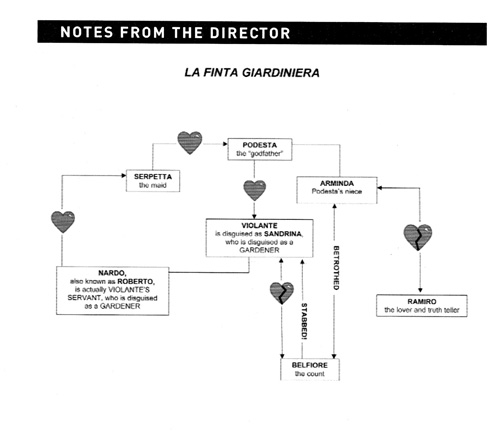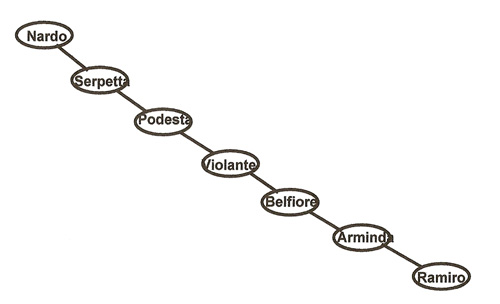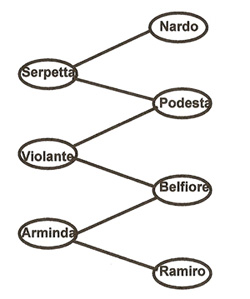On the Thursday evening when I should have been working on “Networks” Homework #3 I escaped with my wife to a performance at Ithaca College of “La Finta Giardiniera”, a comic opera written by Mozart when he was 18 years old. But there in the program for the performance I found “Notes from the Director” consisting solely of the following network diagram (included here with permission of the director, David Lefkowich):

Remarkably, this diagram summarizes a good part of the silly, fun plot, with the rest built around disguised identities, characters milling around in the dark, and unclear romantic allegiances, all staged by the director in an updated, “Sopranos” style. As I watched the action unfold and listened to Mozart’s glorious music, I wondered idly whether the network exchange theory we learned in “Networks” could help predict the outcome of the plot.
Looking closely at the network, we see seven character nodes, connected by edges, some of which have hearts, broken or whole, along them. Along with the edges that represent romantic ties are two that are about other relationships: Arminda as Podesta’s niece and Nardo/Roberto as Violante/Sandrina’s servant. An edge from Belfiore to Violante says “STABBED!” since before the action of the play, Belfiore had stabbed Violante in a jealous fit, and left her for dead. Eliminating these edges, the hearts, and the arrowheads yields a simple linear network of a form that should be familiar to students of “Networks” (with dashes representing the edges):

Following the analytical approach used in the course, we see that Nardo and Ramiro have little power since they have no outside alternatives. Serpetta and Arminda have more power, Podesta and Belfiore less than the two of them, and Violante the most power moreover the opera is named after her, since she is La Finta Giardiniera [the pretend lady gardener].* Violante can chose between Podesta, the ‘godfather’ or governor of the Black Sea town where the play takes place, and Belfiore, whom she loved but who ran away after jealously wounding her and has now shown up in the town where Violante is working as a gardener. If she chooses Podesta, Arminda is free to proceed with her marriage to Belfiore or to respond to Ramiro’s love for her and Nardo is free to wed Serpetta if she will have him. If Violante chooses Belfiore, Podesta may respond to Serpetta’s attraction to him or Serpetta may accept Nardo’s attentions, while Ramiro is free to pursue Armindo.
Redrawing the network as a bipartite graph, with the women on the left and the men on the right, reveals another construct studied in “Networks”:

Not only is this a bipartite graph, but it has a constricted set — there are four men and only three women, so there cannot be a perfect matching. In order to permit a perfect matching, we must add an artificial node, representing bachelorhood or a fourth woman.
However the economic approach developed in “Networks” to handle this kind of network is insufficient to explain which of the possible perfect matchings ensues (as it should be!). This is largely because the model is incomplete in at least two ways. It does not take into account class structure: Serpetta and Nardo are both servants and so in the original era of the play seem more likely to end up together, while Belfiore is a Count, Violante a Countess, and Podesta a mere politician (who, like Tony Soprano, thinks he controls more than he does). Moreover by leaving out the arrowheads our simplification of the network has eliminated the directed nature of some of the edges as well as the heart labels, broken or whole, all of which represent the past and present emotional ties.**
Here is where the 18-year-old Mozart, who did not write the story (which is attributed to Petrosellini) but who uses music in his operas to reveal character and relationships, comes to our aid. Much of the opera consists of negotiations among the participants, working out which exchanges will occur, though unlike the experiments described in the course these are in the form of arias, duets and even ensembles, not Instant Messanger sessions. Thus the climax of the story occurs in the beautiful duet “Tu mi lasci?” [are you leaving me?], in which Belfiore and Violante are drawn together again all the while protesting that they are leaving each other, accompanied by orchestral music that clearly urges reconciliation and union.
And so the opera ends with a “perfect matching”:
VIOLANTE/SANDRINA—–BELFIORE
NARDO/ROBERTO—–SERPETTA
ARMINDA—–RAMIRO
But what of Podesta? Well, he sings ”Ch’io pur mi sposero, Quando un’altra Sandrina trovero” [as for me, I will marry when I find another Sandrina], reconciling himself to having to match to the artificial node after blessing the other three matches.
What if Mozart, like the Ithaca College production, were transported to contemporary times and like me, is auditing ”Networks”? Like me, he might well have had a lot of fun working out this network analysis of his opera without taking the analytical approach any more seriously than he has taken the plot.
(Here is a full summary of the plot of La Finta Gardiniera).
*Professor Kleinberg confirms that this analysis is consistent with experimental results on seven node linear networks, but says that the only stable outcome would give Serpetta, Violanta and Arminda each one and everyone else zero. (Sorry, guys….)
** Professor Kleinberg says he does not know of any extension of network exchange theory to directed graphs, but asks what such a model might capture. I would guess that if A is in love with B but B does not (yet) reciprocate, A is at a power disadvantage with respect to B, while if the edge between C and D is bidirectional together they have power greater than one.


* You can follow any responses to this entry through the RSS 2.0 feed.